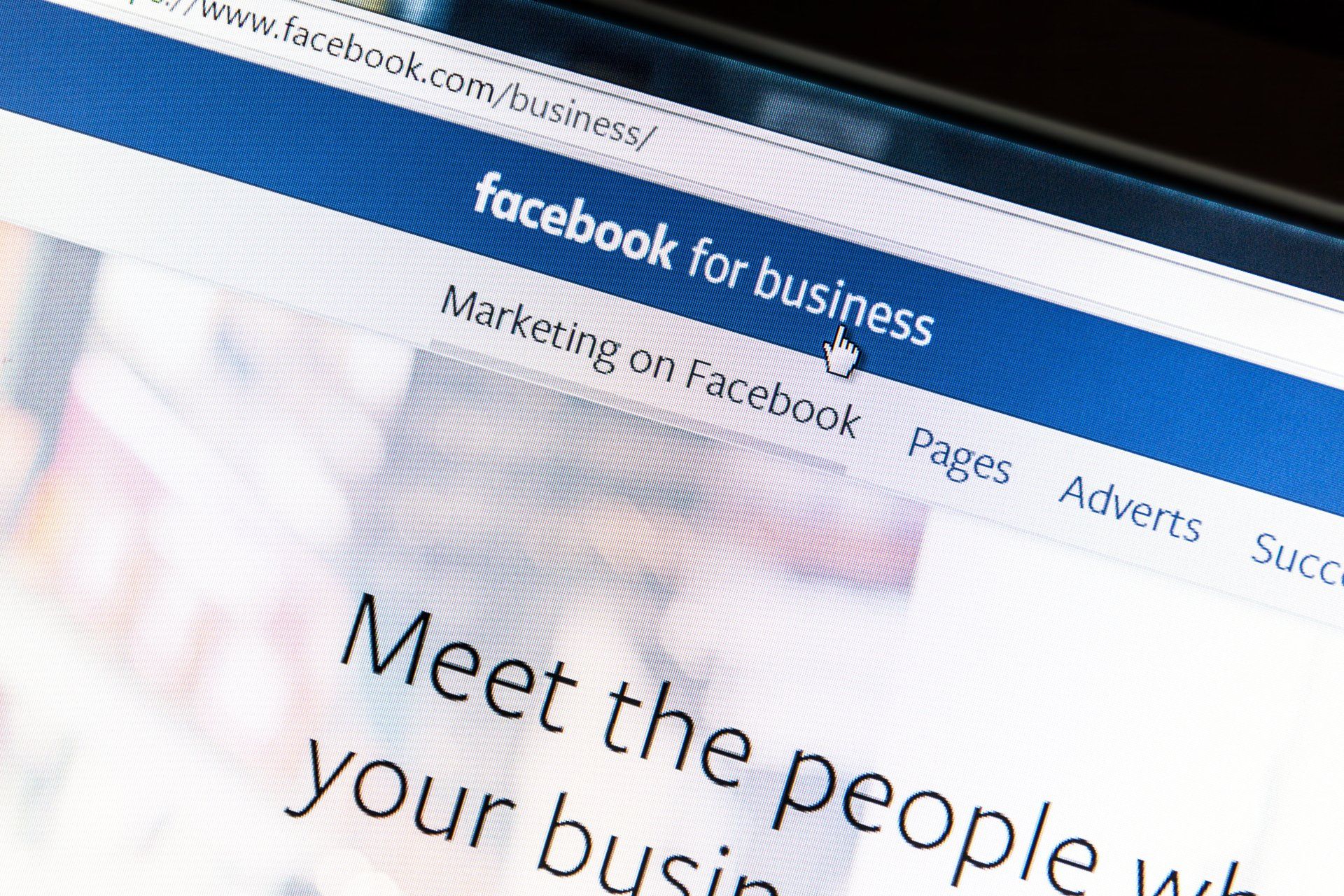Facebook ads mistakes to avoid
Facebook is by far the biggest social media network out there, with nearly 51 million regular users in the UK alone.
It also has one of the biggest and most effective online advertising platforms available.

Not thinking about the end goal
The first step to creating a successful ad campaign on Facebook isn’t creating your ad. The first thing to do is actually to set your goal or objective. You need to be completely clear on this and you need to stick with it.
Facebook gives you a range of objectives to choose from, which can get confusing and you may get sidetracked into choosing the wrong one. But it is very important not to start designing your ad and its message until you are clear about your end goal.
What do you want to achieve from this ad?
Facebook offers 11 objectives to choose from:
- Brand awareness – introduce your brand to a new audience
- Reach – get your ad seen by as many people as possible
- Engagement – reach a wide audience to increase your engagements or likes on Facebook
- Traffic – drive visitors to a particular web page
- Video views – get more people watching your videos
- App installs – encourage people to install your app
- Lead generation – encourage new people into your sales funnel
- Conversions – encourage specific actions on your website, including sales or signing up for subscriptions
- Messages – get people to contact your business through Facebook Messenger
- Catalogue sales – link your ads to the product pages for the items people are most likely to buy
- Store traffic – increase footfall to your bricks and mortar shop
Whatever your aim, your Facebook ads need to align with it right from the start. That way, you will be able to design more relevant advertising campaigns for the audience you want to connect with.
Choosing the right objective from the beginning will stop you wasting money on advertising which doesn’t work. It will also help you to create and run better Facebook ads in the future.
Using the wrong ad type
Facebook offers a range of different types of ads to choose from. This means there are a lot of ways to make your advertising successful, but also a lot of ways to get it wrong!
When choosing the right ad type, you need to focus on both the objective of your ads and what your own target audience would be most likely to engage with.
You should choose the ad format which closely aligns with your advertising objectives. Some of the most popular ad types are:
- Single image – all objectives apart from video views
- Carousel – all objectives except video views and engagement
- Video – all objectives apart from catalogue sales
- Collection – conversions, traffic, store traffic and catalogue sales
- Slideshow – all objectives
Keep A/B testing your ads, to ensure you have chosen the right option for your business and its objectives.
Not testing individual variables
We have talked on this blog before about the value of A/B testing to find out what works and what doesn’t. Experimenting with different versions of your Facebook ads will help you understand what is the most effective.
But it can feel like a slow process and it is tempting to test too many things at once. This is a big mistake. If you test a lot of things at once, you won’t know whether it was the colour change, the image change or the different text which made the difference.
To really understand what works, you should only test one variable at a time, rather than testing multiple variables. So test a blue version and a red version to see which is more effective, before you move on to tweaking the images.
The other key thing to remember here is to test your variables with an equal audience. So if your target market is men aged 25-45 who work in supervisory and middle management roles for large companies, don’t target one variable at the 25-35 year olds and the other variable at the 35-45 year olds, because the audience isn’t equal.
In this case, if you get different results from your testing, you won’t know whether it is because you’ve changed the variables of your ad or because you’ve distorted your audience.
The good news is that Facebook Ads Manager makes it easy to test your ads, and you can actually test them on three different levels:
- Advert set (placement, targeting etc)
- Campaign (lead generation, conversion etc)
- Ad (links, image etc)
But while testing is an integral part of a successful Facebook ad campaign, you need to be sure of your method, or it won’t work. Knowing what you want to test and when is the only way to find out what really works. From there, you can optimise your adverts to ensure a better return on your investment.
Targeting the wrong audience
Over 6 million businesses are using Facebook ads to reach their target audiences. The very best thing about Facebook ads is that they allow you to target a very particular audience. Facebook’s targeting features allow you to work to a budget, yet still connect with the specific audience you are trying to reach.
So it goes without saying that one of the worst things you can do with Facebook ads is to target the wrong audience.
Facebook’s audience as a whole is huge and probably 99% of those people won’t be interested in your products or services. So you shouldn’t target everybody with your ads. More people seeing your ads doesn’t actually mean more people buying your products or services. Some of those people may engage with your brand or click on your links, but if they aren’t interested in what you have to offer and don’t go ahead and buy, you are wasting your money.
The aim with Facebook ads is to get them seen by a significant number of people who would find the ads relevant and would benefit from your product or service.
With every advertising campaign on Facebook, you need to set up a custom audience. You start with the basics – location, age, gender and language – before moving onto your detailed targeting.
To target the right audience, you need to understand them.
One of the best ways to do that is to use Audience Insights, which will you will find above Page Insights. Using this, you can find the common interests and demographics of your audience, including how active they are on Facebook and the pages they like.
You can also do a basic survey of your existing customers, to find out things like their job, age, gender and location. If your survey shows that a lot of women in their 50s who work part-time are buying your products, it would make sense to target this particular audience.
Choosing a too big or too small audience
67% of social advertisers consider Facebook to be the most effective social media platform they use. This is because once you’ve given Facebook all of the information it needs to reach the type of audience you want to target, it will show you the potential number of people you could reach. It is important to choose this number carefully to make the best use of your money.
There is a fine line between reaching an audience which is too big and reaching one which is too small. The aim is to reach that perfect number somewhere in the middle. By looking at the ‘potential reach’ provided by Facebook when creating your advert, you will get an indication if you’re heading in the right direction.
If the potential reach of your ad is 250,000, ask yourself whether your business will benefit from being seen by that many people. Clearly for a large company, that number (or higher) would be right, but for a small local business that is far more people than would realistically be interested in what you have to offer.
If the audience you are trying to reach is smaller than that, you can adjust your targeting to be more specific and reach a narrower and more realistic number of people.
But beware of reducing the audience by too much, because Facebook doesn’t show ads to a very small audience.
To get a good return on your advertising spend, you need to balance:
- The size of your audience
- The quality of your audience
- The amount you are paying to reach that audience
So how can you be sure whether your audience is too big, too small or just the right size?
- Collect data from a bigger audience – targeting a broad audience initially isn’t a bad thing. You might waste a little bit of your budget by reaching the wrong people, but you will pick up valuable data which will help you learn about the right people to target. This gives you the room to learn and make adjustments to your audience one step at a time. If you start with a small audience, you won’t be able to pick up enough data to help you make decisions on future campaigns.
- Focus on your conversions – an advert is pointless if it doesn’t lead to conversions (unless you are advertising purely for brand awareness). The aim should always be to get a good conversion rate (eg sales, signing up for a subscription or trial, donating to a charity etc) without burning up a huge budget. The more specific your reach, the more expensive each click will become, so you will pay more for ‘women in Gloucestershire who are 35-50 and like shoes’ rather than ‘women in the UK who like shoes’. So the key thing is to know when to stop narrowing your targeting down. When you reach your optimal audience size, you shouldn’t need to apply any more levels of targeting.
- Be brave and try a smaller audience – When you target your Facebook ads effectively, you will get a better response in terms of clicks and sales. Targeting a narrower audience means your ad will be highly relevant to the people who see it, giving you the potential to earn a better return on your investment. If you know your niche well, you can be brave and target a much smaller audience which is more likely to buy from you. There will be some trial and error, but you will learn more about your audience as you move forward, meaning you can improve your ads every time.
Failing to use video
If you’re not using video for your Facebook ads, you are missing a trick.
A recent survey showed that around 7 out of 10 people thought Facebook ads were relevant, and that most consumers like video better than images in ads.
Interestingly, most consumers prefer to watch their videos without the sound on, so it is important to adapt to that to make sure you can still get your message across. If your video is meaningless without sound, you have wasted time and money on creating an ineffective ad.
That’s why it is important to create video ads with subtitles which are easy to read. Facebook has made this possible as part of its own ad creator.
Not using a quality image
Facebook has 2.6 billion active users worldwide. Between them, they are sharing hundreds of millions of pieces of content every day. So how do you make your ad stand out when your target audience are scrolling through Facebook?
Images are really key to the performance of a Facebook ad. In fact, they can make up to 90% difference. So if you don’t focus on using an image which is good quality, eye catching and relevant, you will be losing money and not getting the return on investment you were aiming for.
It goes without saying that a Facebook ad is a visual thing. People see an image before they read your copy. The image you use needs to be interesting enough for a person to stop scrolling and take a look at it. If the image you use isn’t going to appeal to your target audience, you won’t attract their attention and they won’t click on your ad.
When advertising on Facebook, you have a choice of a single image ad or multiple image ads in the form of slideshow, carousel or collection ads. These multiple image choices can make your ads even more engaging, leading to an increase in clicks and conversions, but only if you get the images right!
So how do you choose the right image for your ads?
The key thing is to always focus on the purpose of your ad, which could be for conversions, reach, engagement or even to drive footfall to a physical store. Your ad is essentially an offer to your audience, which will drive them to take the action you want them to take. Your images, whether photos, graphics or a mixture of the two, need to fit with that objective.
Every single image you use on your Facebook ads should be relevant to your offer to your potential customers. Using a random image which isn’t relevant to your product, service or brand won’t help you achieve your objectives and is a waste of your advertising budget.
But while your image needs to grab attention and encourage your audience to take the next step, it shouldn’t be so distracting that it will stop people from reading your copy and clicking on your link.
If you haven’t got quite the right images, you can use a tool like Canva to enhance and customise them to make them work for your campaign.
Changing your ad too soon
Your Facebook ads aren’t going to produce miracles overnight, so it is important not to give up on them too soon. You are investing money in your ads and it is understandable that you want to see results quickly. It is not unusual to feel like you are wasting money at the start.
But it is important to be patient and not start changing your ads too soon. In fact, it is important to allow your ads to run in their original form for a little while, so that you can pick up valuable data. This data will give your more insight into what works and what doesn’t and can help you improve your ads for the future.
Ideally you should wait until your ads have reached 1,000-2,000 people before making any changes. This should give you enough data to learn from and make decisions on where to go next – whether that is to tweak your ads to make them even better or look at where they went wrong so you can make more radical changes.
A good starting point is to consider how much you are willing to spend on advertising to pick up a single sale. It might be that you are happy to break even on your first sale (essentially all of your profit spent on advertising), but that won’t be a trend you will want to continue in the long-term as your advertising gains momentum.
So after that initial expensive sale, you should learn from your ads and make gradual changes to optimise them, which will bring better results for your business.
Failing to use the Facebook pixel
Facebook ads use a piece of code called the pixel, which helps an advertiser learn more about their audience and the actions they take. Using the Facebook pixel helps you to improve the targeting of your ads.
The Facebook pixel is a very effective way to collect data from your own website. From this, you can tell more about your audience and the way they engage with your brand on Facebook. This means you can create better ads which will engage your audience and increase your conversions.
If the objective for your ads is lead generation, Facebook doesn’t understand what that means to your business before you have actually generated some leads. Once you begin picking up leads, it will start to show you the relevant data.
It is very easy to set up the pixel when setting up your ads, by simply following the prompts.
The key reasons for using it are:
- It helps you optimise your ads effectively, so that you can increase your conversions
- It helps you build custom audiences by remarketing to website visitors through your Facebook ads
- It tracks conversions on your site, so you know how much of your advertising traffic is converting to leads or sales
If you don’t use the pixel, you are missing out. People who have visited your website already are likely to be more interested in what you have to offer than a completely cold audience. The pixel offers you a way to reach them again easily through Facebook. By targeting this audience, you increase your chances of making a sale – and at a lower cost than targeting a completely new audience.
Facebook ads are a really essential advertising tool which work well for most businesses. But with so many different options to get them right, there are also many chances to get them wrong. Take your time to focus on your objectives and your audience, and keep A/B testing to get the best results for your business.
More Posts.










